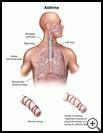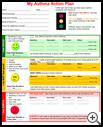
Asthma: Brief Version
What is asthma?
Asthma is a long-term breathing problem. Your child may have a lot of attacks with wheezing (a high-pitched whistling sound when the child breathes) and coughing. It can be hard for your child to breathe. Asthma attacks can be triggered by exercise, cold viruses, cold air, strong emotions, and smoke. Attacks can also be caused by pollens or animal dander.
How can I take care of my child?
- Make sure your child uses the asthma medicine your healthcare provider prescribed. Your child may need more than one type of medicine: one to prevent attacks (long-term control medicine) and another to help stop an attack once it has started (quick-relief medicine). Ask your healthcare provider when to use each kind. Make sure that you and your child know when and how to use all medicines the right way.
Long-term control medicine (also called controller): This medicine helps prevent asthma attacks.
Quick-relief medicine (also called rescue medicine): If your child is having asthma symptoms (wheezing, coughing, trouble breathing), he should take his quick-relief medicine.
- Use a spacer. Metered dose inhalers (MDIs) should always be used with a spacer. This attaches to the inhaler and helps your child get all the medicine to his lungs. Use a mask if your child has trouble with the mouthpiece. Make sure you have a mask that fits.
- Your child may need to use a nebulizer to take his medicine.
- Oral steroids or other medicine. Your healthcare provider may prescribe a medicine to take by mouth.
- Don't wait to start treatment. Start the inhaler or medicine when your child first coughs or wheezes.
- Have your child use an inhaler before exercise. Your child may also cough or wheeze during exercise. Use a quick-relief (reliever) medicine 15 to 30 minutes before your child plans to exercise.
How can I help prevent asthma attacks?
- Make sure your child stays away from triggers like feather pillows, tobacco smoke, and pets.
- Learn how to dust-proof your child's bedroom.
- Have your child take a bath or shower. This can help if your child wheezes after being around grass, tree, or weed pollens, or animals.
Call your child's healthcare provider right away if:
- Your child has a hard time breathing or the wheezing is severe.
- The wheezing does not get better after the second dose of quick-relief asthma medicine.
- Your child's peak flow is in the red zone.
Call your child's healthcare provider within 24 hours if:
- The wheezing is not completely gone in 5 days.
- Your child needs to use the quick-relief inhaler every 4 hours for more than 1 day.
- You have other questions or concerns.
Written by Barton D. Schmitt, MD, author of “My Child Is Sick,” American Academy of Pediatrics Books.
Pediatric Advisor 2018.1 published by Change Healthcare.
Last modified: 2016-06-01
Last reviewed: 2017-06-05
Last modified: 2016-06-01
Last reviewed: 2017-06-05
This content is reviewed periodically and is subject to change as new health information becomes available. The information is intended to inform and educate and is not a replacement for medical evaluation, advice, diagnosis or treatment by a healthcare professional.
Copyright ©1986-2018 Barton D. Schmitt, MD FAAP. All rights reserved.


